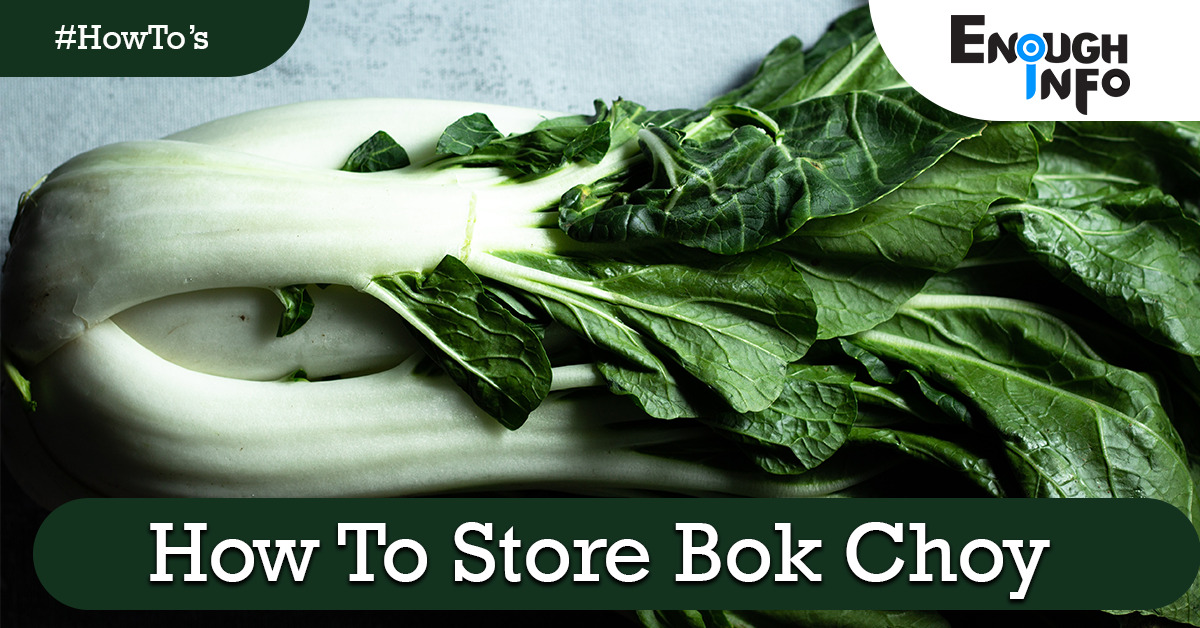How To Store Bok Choy

How To Store Bok Choy: The green leafy vegetable Bok Choy, often called Peking’s cabbage, is typically used in Asian cuisine. It contains substances known as glucosinolates that may aid in cancer prevention. It is one of the top superfoods and is a calcium, folate, and beta carotene powerhouse. Along with being high in vitamins A, C, and K, it also has a moderate taste. EnoughInfo.com

Bok choy may be either raw or cooked and is often used to salads and stir-fries. Additionally, it is low in calories and offers a host of health advantages, including bettering immunological function, encouraging heart health, and enhancing digestion. Unfortunately, if not kept properly, this vegetable may quickly deteriorate, much like other leafy greens. You will be deprived of this amazing vegetable’s ability to fight cancer as a result. Stop this from happening. Make some preparations to store Bok Choy at home. How To Know Your Girlfriend Is Cheating On You
FAQs & Answers on How To Store Bok Choy
1. Does Bok Choy need refrigeration?
Bok choy doesn’t always need to be kept in the refrigerator. However, if you have the room, we advise keeping it in the refrigerator to help prolong its shelf life. How should washed bok choy be stored? Bok choy should be kept in the refrigerator in a plastic bag for the best storage results.
2. What part of Bok Choy do you eat?
This amazing tiny plant provides a great source of fiber, beta-carotene, and vitamins C, K, and A. The nice part is that both the leaves and the stalks may be eaten. Both calcium and vitamin B6 are abundant in it. Bok choy’s taste, size, and color may all vary. How To Confuse A Narcissist
3. What is the best way to eat bok Choy?
Bok choy is commonly used in Chinese or asian cuisine, usually as a stuffing for spring rolls, potstickers, steamed buns, and dumplings as well as in soups, salads, and stir-fries. When stir-fried in sesame oil with some garlic, ginger, and soy sauce or salt, its delicate taste really comes through.
Read Also: How To Season Cast Iron Without Oven
How To Store Bok Choy
Bok choy must be washed before being preserved in several methods. This stage is more difficult than it seems since the vegetable is a thick, leafy one. Bok choy conceals dirt particles between its leaves, so you must properly clean it before cooking and eating it. Learn how to store bok choy prepare, package, and preserve this healthy vegetable so you may always take advantage of its deliciousness. How To Get Someone That is Close-off To Open Up To You
1. Wash bok choy
Just washing the surface of the bok choy is insufficient. It has to be chopped and its stalks separated in order to expose all the dirt. Slice a layer off the bottom of the mature vegetable to do this. By carefully peeling the stalks off the base, you will be able to separate them. After that, you may wash it away just as you would wash lettuce leaves. How To Start A Car With A Bad Fuel Pump
- Baby bok choy must be cut in half or halves lengthwise before washing. You may exclude the base from baby bok choy as it is smaller in size. The vegetables may then be washed off with water. Use a soft vegetable brush to clear it out if the dirt is really entrenched.
- After washing, rinse the bok choy in a strainer. After that, use a paper towel to gently dry it off completely. You may then either save it or use it in your cooking. Health Benefits Of Pomegranates (Step By Step)
2. Storing Bok Choy In The Refrigerator
Bok choy may be kept in a refrigerator in many ways:
Store in Zipper Bag:
Bok choy shouldn’t be washed before being put in the refrigerator. If you do, rot will be encouraged by the wetness. Place the unwashed veggie in a plastic zipper bag as an alternative. Make holes in the bag to allow air to circulate and prevent the veggie from wilting. Eat this within three to four days.
Wrap in Paper Towel:
Bok choy’s base should be cut off, and the vegetable’s stalks should be separated. Keep the white stems since they are often used in recipes. The divided leaves should be put into a big basin filled with cold water. To remove any extra water, rinse the leaves and shake them. After that, dab them dry with a paper towel. Place the bok choy leaves on brand-new, fresh paper towels and roll them up after they have dried fully. Put the leaf rolls in a zip-top plastic bag. Put the bag in the refrigerator’s crisper drawer. For around five to six days, the bok choy should remain fresh. How To Make Crutches More Comfortable
Read Also: How To Keep Cilantro Fresh( The Ultimate Guide)
Place in Water:
Take a container and put ice water in it. Place the jar with the stems standing erect in it in your refrigerator. Eat the veggies within a day or two.
Freezing bok choy
The majority of us are aware that veggies don’t freeze properly. Many of us have seen frozen leafy greens turn to mush when kept there for an extended period of time. Your bok choy won’t become a pulp if you follow the below procedure, and you can still utilize it in all of your recipes. Here are a few examples:
Blanching:
Use the aforementioned approach to wash your bok choy. After cleaning it, put some water in a saucepan and bring it to a boil. Dunk the bok choy leaves into the boiling water for two minutes. Then, as soon as you remove them, dip them into cold water to halt the cooking. After using a paper towel to dry the leaves, put them into freezer bags that are airtight. As little air as possible should be present within the bags. After that, put them in the freezer’s deepest compartment. How To Conduct A Market Research For Your Business Idea
Blanching without Freezing:
Some individuals like to freeze their bok choy without blanching it first. In fact, they prefer little to no touch with water since this might trigger the decaying process. Use paper towels to wipe out your veggie before using this procedure. The vegetable’s base should be cut, the stems should be separated, and they should be well cleaned with wet paper towels.
After that, slice the stem and leaves into small pieces on a chopping board. To remove any extra air, place the pieces inside a freezer bag and put the bag flat. Place the bag into the freezer after sealing it. 14 Pricing Strategies For Service-Based Businesses
Within a year, the vegetable may be utilized.
Read Also: 6-Day Low Carb Meal Plan Ideas(The Ultimate Guide)
Pressure canning bok choy
You must first blanch the bok choy before you can it under pressure. Boiling water should be used to cook the cleaned bok choy. After two minutes, remove it using a fish net. To halt the cooking, immerse it in icy water for two minutes. After that, drain it and put it in clean canning jars.
Fill the jars to about one inch from the top with hot water once they have been lightly filled. Add the jars to the pressure canner after sealing the lids.
In a dial-gauge canner, a pint-sized jar can be processed for 70 minutes at 11 pounds of pressure. Once the leaves are wilted by the compressed steam, you will be amazed at how much bok choy you can put into each jar. Up to 28 pounds of greens may fit inside a 7-quart canner load.
You may preserve these cans for a year or perhaps longer if you keep them in a cold, dry location.
Drying or Dehydrating Bok Choy
To extend the shelf life of the bok choy, dehydrate it. Beginning with the bok choy, prepare it by clipping its ends and washing it as directed in the preceding technique. Boiling water is used to blanch the bok choy for a few minutes. After that, remove it and place it in an ice bath. After the greens have cooled, strain them in a sieve and pat or spin them dry with paper towels. 8 Groups of Foods Best For Eye Health
Read Also: Best Foods To Boost Testosterone(2023 Guide)
The bok choy may be dried in two different methods
Bok choy should be dried out in a food dehydrator until its leaves have a brittle quality. Place the clean bok choy on a dehydrator tray. If your dehydrator is set to 140 degrees Fahrenheit, it typically takes 8 to 10 hours to do this. How To Not Be A Simp (Ultimate Guide)
For those without a dehydrator, you may dry the vegetable in a bake oven. Bok choy should be placed on a baking pan and baked at the lowest setting. Given that the oven lacks the airflow that is produced in a dehydrator, this process will take a lot longer than using a food dehydrator.
Pickling Bok Choy
Despite its low popularity, pickling bok choy is one of the best and tastiest ways to preserve it for months. To pickle bok choy, sterilise the container.
Boil the jar for 10 minutes to kill bacteria. Turn off the hob but leave the pot on to keep the jars heated. Complex Sleep Apnea Syndrome Treatment
Clean bok choy before chopping. Insert the warm jar of sliced bok choy. prepare bok choy pickling brine. For every pound of bok choy, use 1/2 cup water, 1 cup vinegar, 1 tablespoon sugar, and 1/2 tablespoon salt.
Boil the pickling brine for 3 minutes before filling the container. After room temperature, refrigerate the container. Bok choy pickles can be flavoured with cayenne, ginger, fennel seeds, black pepper, coriander, and others. This preserves bok choy for five to six months.
Stores sell bok choy in seedling, baby, flowering, and mature stages. These phases seem quite different and can mislead buyers. The conventional white-stemmed, green-stemmed, and dwarf white-stemmed varieties of bok choy complicate matters. However, you shouldn’t avoid bok choy. Bok choy is a must-try. Bok choy stands out among Chinese cabbages. When cooked, they become creamy, pureed, and crunchy.
Conclusion
When storing bok choy, make sure to use an airtight container or wrap it in plastic and place it in the refrigerator. With the right temperature and humidity levels, bok choy can last up to a week while still maintaining its freshness and flavor. Additionally, be sure to periodically check on your bok choy for any signs of spoilage.
Recommended;
Health Benefits Of Chia Seeds(All You Need To Know)
What is Intuitive Eating? (10 Benefits to Your Well-being)
11 Benefits of Organic Skincare for Sensitive Skin




